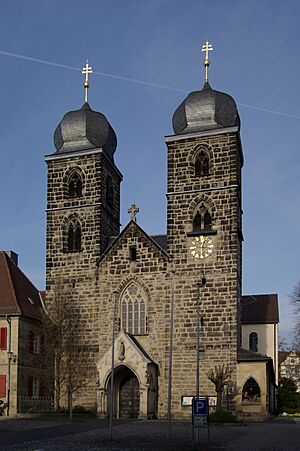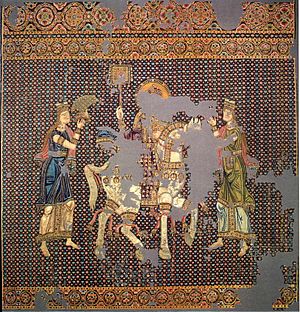Gunther of Bamberg facts for kids
Gunther (born between 1025 and 1030 – died July 23, 1065) was an important German nobleman and church leader in the Holy Roman Empire. He worked as the Chancellor of Italy from 1054 to 1057. After that, he became the Bishop of Bamberg in 1057 and served until he died. He was also the leader of a very big trip, known as the Great German Pilgrimage of 1064–65, during which he passed away.
Gunther was often at the Emperor's court. He enjoyed a fancy lifestyle and supported writers and artists. He helped bring back German literature by asking for the Ezzolied to be written just before his big pilgrimage. When he died, he was buried in a special, rich silk cloth called the Gunthertuch, which he had gotten during his journey.
Gunther's Family Background
Even though Gunther was from a very important noble family, we don't know exactly who his parents were. A writer named Lampert of Hersfeld said that Gunther "was born among the first people of the palace." This means he was very close to the court of Emperor Henry III, who died in 1056.
Historians have two main ideas about his family. One idea links him to the Margraves of Meissen, based on old records of deaths and land he owned. Another idea, looking more at his land, suggests Gunther was the son of a count named Pilgrim. This count owned lands like Salaberg and Haag and was related to the Aribonids.
Gunther's mother was named Gerbirg. She died sometime between 1050 and 1060. One historian, Ernst Klebel, thought she might have been from the Eppensteiner family. This family was known for being Dukes of Carinthia. If this is true, it would mean Gunther was related to Adalbero, the bishop who came before him in Bamberg.
Gunther himself owned a lot of land across the area known as the March of Austria and in Carinthia.
Gunther's Church Career
Gunther was a church official called a provost in Hainburg from at least 1051. He also held a position as a canon (a type of priest) in the church of Saints Simon and Jude in Goslar. Emperor Henry III chose him to be the Chancellor of Italy. We first see him in this role on May 31, 1054. As chancellor, he worked closely with Pope Victor II and Empress Agnes of Poitou, who was Henry III's wife.
After Henry III died, Agnes became the ruler for her young son, Henry IV. She kept Gunther as chancellor. Because Agnes wanted him to, Gunther was chosen as the Bishop of Bamberg in March 1057. Henry IV confirmed this on March 30. After Gunther, Wibert of Parma became chancellor, likely because Gunther suggested him.
In church matters, Gunther was a friend of Archbishop Anno II of Cologne. Anno had been in charge of the church school in Bamberg until 1054. With Anno's help, Gunther got back church lands in Forchheim and Fürth. In Bamberg itself, Gunther built the collegiate church of Saint Gangolf. Like many church leaders who got their jobs from the Salian emperors, Gunther supported the Gregorian church reform ideas, but he didn't push them too hard.
Gunther held the first big meeting of church leaders in Bamberg on April 13, 1059. At this meeting, they rejected 19 claims for land and power made by the diocese of Würzburg. Even in 1063, there was still a disagreement about church taxes in Neubruch. At the same meeting, Gunther said he wanted to make the Slavic people living in his area follow church marriage rules and pay church taxes. If they didn't, they would be forced to leave.
In 1060, Gunther had a disagreement with Empress Agnes. She refused to support his claim to control the monastery of Bergen, which was also claimed by the diocese of Eichstätt. Because of this, he stopped attending the court. There were even rumors that he was planning a rebellion. These rumors were used by some people as an excuse to take land that belonged to Bamberg. He made up with Agnes a little bit in late 1061. But it was only when she stepped down from power in 1062 (during the Coup of Kaiserswerth) that he fully made peace with the Emperor's court.
The Great Pilgrimage
In 1064, Gunther led a large group of pilgrims to Jerusalem. Archbishop Siegfried of Mainz also went with him. According to old records, they first traveled to Constantinople, which was the capital of the Byzantine empire. They went through Hungary, which was a new land route for pilgrims. This route had only become open after Hungary became Christian in the years before. The same records say that the young Gunther was thought by Byzantine officials to be Emperor Henry IV in disguise. Because of this, he faced some problems in Constantinople.
When they reached Latakia, Gunther got a warning that groups of Muslim bandits were ahead. His group of pilgrims was attacked near Caesarea and many people were hurt or killed. The bandits were probably drawn to the expensive things Gunther had brought with him. The pilgrims were not armed and weren't sure if it was right for them, as pilgrims, to fight back. But in the end, some of them did.
The delay caused by the bandits meant Gunther couldn't reach Jerusalem in time for Easter. He ended up spending only thirteen days in the city. He left Jerusalem to go home on April 25, 1065. He died in Ödenburg while passing through Hungary on July 23.
Gunther brought back a special Byzantine silk cloth from his pilgrimage. It's called the Gunthertuch (Gunther cloth). It shows a man on a horse receiving crowns from two female figures. He was buried with this cloth under the altar of Saint Gertrude in the original Bamberg Cathedral. Later, in the 1200s, when the cathedral was rebuilt, his body was moved and reburied in the east choir, called the Georgenchor.
Supporting Writers and Art
Gunther is a very interesting person from the 11th century because of the detailed letters written by his church school leader, Meinhard. Meinhard criticized the bishop for his fancy lifestyle. He even joked that Gunther was so lazy and fat that he needed "mechanical devices" to be "rolled out of bed"! Meinhard also didn't like Gunther's taste in stories, which were mostly about kings and heroes, like the legends about Theoderic the Great.
According to Meinhard, Gunther "never thought about Augustine, never about Gregory, [but] was always discussing Attila, always the Amalung and others of that kind." Some historians think, based on Meinhard's writings, that Gunther might have written his own poems or even taken part in "plays" or knight games at court.
Gunther asked for the Ezzolied to be written. This was the first major poem in Middle High German language. It was important because no big works in German had appeared for over 150 years. The Ezzolied was written by Ezzo, and its music was made by Willo, both priests from Bamberg. In one old copy, the first part of the Ezzolied explains how Gunther ordered it:
- Der guote biscoph Guntere vone Babenberch, (The good Bishop Gunther of Bamberg,)
- der hiez machen ein vil guot werch: (he ordered a very good work to be made:)
- er hiez di sine phaphen (He ordered his priests)
- ein guot liet machen. (to make a good song.)
The Ezzolied tells the story of God's work from the creation of the world to the crucifixion of Jesus. Another bishop, Altmann of Passau, who was on the pilgrimage with Gunther, said that the writer of the Ezzolied was also on the trip and wrote the song to be sung during the journey. Other ideas suggest the song was written when Gunther made his church officials follow new rules, or when Saint Gangolf's church was dedicated. Some even think it was written to give Gunther a religious poem in German that could be as popular as the stories about Theoderic the Great, which Meinhard criticized him for liking.



